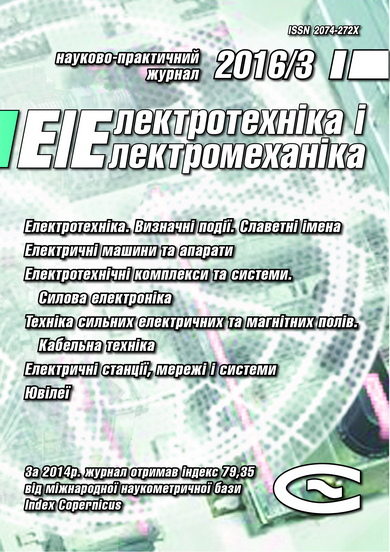DYNAMICS MODEL OF MOISTURE IN PAPER INSULATION-TRANSFORMER OIL SYSTEM IN NON-STATIONARY THERMAL MODES OF THE POWER TRANSFORMER
DOI:
https://doi.org/10.20998/2074-272X.2016.3.02Keywords:
oil-paper insulation, power transformer, computer model, moisture dynamicsAbstract
Introduction. An important problem in power transformers resource prognosis is the formation of moisture dynamics trends of transformer insulation. Purpose. Increasing the accuracy of power transformer insulation resource assessment based on accounting of moisture dynamics in interrelation with temperature dynamics. Working out of moisture dynamics model in paper insulation-transformer oil system in conjunction with thermodynamic model, load model and technical maintenance model. Methodology. The mathematical models used for describe the moisture dynamics are grounded on nonlinear differential equations. Interrelation moisture dynamics model with thermodynamic, load and technical maintenance models described by UML model. For confirming the adequacy of model used computer simulation. Results. We have implemented the model of moisture dynamics in power transformers insulation in interrelation with other models, which describe the state of power transformer in operation. The proposed model allows us to form detailed trends of moisture dynamics in power transformers insulation basing on monitoring data or power transformers operational factors simulation results. We have performed computer simulation of moisture exchange processes and calculation of transformer insulation resource for different moisture trends. Originality. The offered model takes into account moisture dynamics in power transformers insulation under the influence of changes of the power transformers thermal mode and operational factors. Practical value. The offered model can be used in power transformers monitoring systems for automation of resource assessment of oil-immersed power transformers paper insulation at different phase of lifecycle. Model also can be used for assessment of projected economic efficiency of power transformers exploitation in projected operating conditions.References
1. E'kspertnaya sistema monitoringa, diagnostiki i upravleniya transformatornym oborudovaniem «E'SMDU TRANS» proizvodstva PAO «ZTR» (Expert system for monitoring, diagnostic and control of transformer equipment «E'SMDU TRANS» produced by PAO «ZTR») Available at: http://www.ztr.com.ua/ru/monitoring-system. (accessed 13 May 2014). (Rus).
2. Rusov, V.A., Ovsyannikov, A.G., Zhivodernikov S.V. Foreign experience of oil-filled equipments monitoring. Materialy IV nauchno-prakticheskogo seminara Obshchestvennogo soveta spetsialistov Sibiri i Vostoka po problemam monitoringa transformatornogo oborudovaniya i diagnostiki elektricheskikh ustanovok [Proceedings of the IV scientific workshop of the Public Council of experts of Siberia and the East on the monitoring of transformer equipment and diagnostics of electrical installations]. Novosibirsk, Russia, 20-24 April 2009, pp. 7-22. (Rus).
3. Cheng J., Robalino D., Werelius P., Ohlen M. Advanced technique for moisture condition assessment in power transformers. Journal of International Council on Electrical Engineering, 2014, vol.4, no.3, pp. 185-191. doi: 10.5370/JICEE.2014.4.3.185.
4. Mordkovich A.G. The system of management, monitoring and diagnostics of transformers SUMTO. ELEKTRO. Elektrotekhnika, elektroenergetika, elektrotekhnicheskaia promyshlennost' – ELEKTRO. Electrical engineering, power industry, electrical industry, 2007, no.6, pp. 23-28. (Rus).
5. Lizunov S.D., Lokhanin A.K. Silovye transformatory. Spravochnaia kniga [Power transformers. Handbook]. Moscow, Energoizdat Publ., 2004. 616 p. (Rus).
6. Polyakov M.A., Vasilevskij V.V. Prediction of wearing out of power transformer winding insulation. Tekhnichna elektrodynamika – Technical electrodynamics, 2014, no.5, pp. 65-67.
7. Du Y., Zahn M., Lesieutre B.C., Mamishev A.V., Lindgren S.R. Moisture equilibrium in transformer paper-oil systems. IEEE Electrical Insulation Magazine, 1999, vol.15, no.1, pp. 11-20. doi: 10.1109/57.744585.
Downloads
Published
How to Cite
Issue
Section
License
Copyright (c) 2016 V. V. Vasilevskij

This work is licensed under a Creative Commons Attribution-NonCommercial 4.0 International License.
Authors who publish with this journal agree to the following terms:
1. Authors retain copyright and grant the journal right of first publication with the work simultaneously licensed under a Creative Commons Attribution License that allows others to share the work with an acknowledgement of the work's authorship and initial publication in this journal.
2. Authors are able to enter into separate, additional contractual arrangements for the non-exclusive distribution of the journal's published version of the work (e.g., post it to an institutional repository or publish it in a book), with an acknowledgement of its initial publication in this journal.
3. Authors are permitted and encouraged to post their work online (e.g., in institutional repositories or on their website) prior to and during the submission process, as it can lead to productive exchanges, as well as earlier and greater citation of published work.





